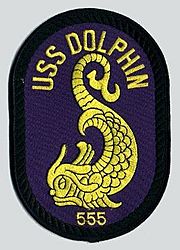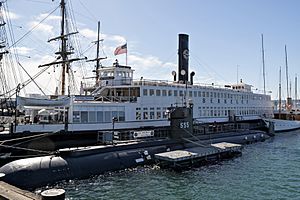USS Dolphin (AGSS-555) facts for kids

USS Dolphin (AGSS-555)
|
|
| History | |
|---|---|
| Namesake | Dolphin |
| Ordered | 10 August 1960 |
| Builder | Portsmouth Naval Shipyard |
| Laid down | 9 November 1962 |
| Launched | 8 June 1968 |
| Sponsored by | Mrs. Maggie Shinobu Inouye |
| Commissioned | 17 August 1968 |
| Decommissioned | 15 January 2007 |
| Out of service | 22 September 2006 |
| Stricken | 15 January 2007 |
| Status | Museum Ship at the Maritime Museum of San Diego |
| Badge |  |
| General characteristics | |
| Class and type | Dolphin-class submarine |
| Displacement |
|
| Length | 46.3 m (151 ft 11 in) |
| Beam | 6 m (19 ft 8 in) |
| Draft | 4.8 m (15 ft 9 in) |
| Propulsion |
|
| Speed | |
| Endurance | 15 days |
| Test depth | 3,000 ft (910 m) (unclassified) |
| Capacity | 12 tons on external mounting pads, six port, six starboard, forward and aft of sail |
| Complement | 3 officers, 20 men, 4 scientists |
| Armament | smallarms. No internal torpedo tubes. An external tube could be mounted to be used for experiments. |
| Notes | fitted with a 20-ton keel section to be jettisoned by explosive bolts for surfacing under emergency conditions |
The USS Dolphin (AGSS-555) was a special submarine used by the United States Navy. It was powered by diesel engines and electricity. The Dolphin was built for deep-sea research and testing new technologies. It served for 38 years, from 1968 to 2007, which was the longest time any U.S. Navy submarine has ever served. It was also the very last submarine in the Navy that didn't use nuclear power.
Contents
Building and Launching the Dolphin
The Dolphin was built at the Portsmouth Naval Shipyard in Kittery, Maine. Its main frame, called the keel, was put in place on November 9, 1962. The submarine was officially launched into the water on June 8, 1968. Mrs. Maggie Shinobu Inouye, whose husband was U.S. Senator Daniel Inouye, was the sponsor for the ship. The Dolphin was officially ready for service, or commissioned, on August 17, 1968. Lieutenant Commander J.R. McDonnell was its first captain.
The Dolphin's hull number, "555", is quite unique. Most submarines built around the same time had much higher numbers. The reason why "555" was chosen for the Dolphin is not known.
How the Dolphin Was Designed
The most important part of the Dolphin's design was its strong outer shell, called the pressure hull. This hull was shaped like a simple cylinder with rounded ends. It was built to be very strong for deep dives and to help with experiments. The designers made sure there were very few openings in the hull. This helped keep it strong and prevented water from getting in. The submarine did not have a special pipe, called a snorkel, to run its engines underwater. This meant the main hatch had to be open when the diesel engines were running.
What the Dolphin Was Used For
The Dolphin was used by both Navy scientists and civilian researchers. It had many special tools and sensors. These helped it do important jobs like:
- Studying sounds deep in the ocean and near coastlines.
- Mapping the ocean floor.
- Testing new weapons and sensors.
- Evaluating new engineering ideas.
Because the Dolphin was made for testing, it could be changed easily. It could carry up to 12 tons of special equipment, both inside and outside. It had places to attach gear and many connections for electronic devices.
Important Missions and Achievements
The Dolphin had many amazing achievements during its time in service.
- In August 1969, it launched a torpedo from the deepest depth ever.
- It was the first submarine to send messages using light (lasers) to an aircraft.
- It helped develop a special antenna for other submarines to communicate at very low frequencies.
- It tested new ways to find submarines without using sound.
- It was the first submarine to launch a special device called a mobile submarine simulator (MOSS).
- It successfully tested a new sonar system called BQS-15.
- It developed a very accurate system to track objects towed behind the submarine.
- It helped create a new sonar system to avoid obstacles underwater.
- It tested a new system to manage targets with high accuracy.
- It even helped scientists study a possible "fifth force of nature."
- It made the deepest submarine dive, going more than 3,000 feet underwater.
In the late 1990s, the Dolphin tested a new sonar system. Because of its work, this new system is now being added to other Navy ships.
Fire and Rescue at Sea
On May 21, 2002, while the Dolphin was about 100 miles off the coast of San Diego, California, something went wrong. It was nighttime, and the submarine was on the surface, recharging its batteries. A seal on a torpedo shield door broke, and water started rushing into the boat. The ocean had strong winds and big waves, about 10 to 11 feet high. A lot of seawater, about 70 to 85 tons, poured into the submarine. This was a very dangerous amount, close to what would make the submarine sink.
The water caused electrical panels to short circuit, which started fires. Chief Machinist's Mate John D. Wise Jr. bravely dove into the cold, 57-degree water of the flooded pump room. With very little air space, he made sure the water valves were set correctly so the pumps could start removing the water. He stayed in the pump room for over 90 minutes to keep a pump from getting blocked. His heroic actions saved the ship and everyone on board. He later received the Navy and Marine Corps Medal for his courage.
After 90 minutes, the situation was under control. All crew members were safely rescued, with only a few minor injuries. Some crew members were picked up from the water by a United States Coast Guard helicopter. Another ship, the McGaw, took the crew to San Diego. The USS Thach also helped rescue crew members from the water, but the waves were too rough for towing.
The crew's quick actions helped stabilize the submarine. The support vessel Kellie Chouest arrived the next day to help. The Dolphin was then towed back to San Diego.
Retirement and Museum Life
After the fire, the Dolphin underwent three and a half years of repairs and upgrades. This cost about $50 million. It then returned to service for another year in 2005.
In mid-2006, the Navy decided to retire the Dolphin. They said it cost $18 million each year to operate. It was officially taken out of active service on September 22, 2006. On January 15, 2007, it was fully decommissioned and removed from the Navy's list of ships. Its 38-year career was the longest for any U.S. Navy submarine.
In September 2008, the Dolphin was given to the Maritime Museum of San Diego. It became the eighth ship in their collection that floats on the water. The Dolphin opened to the public for tours on July 4, 2009.
Awards Received
The USS Dolphin received several awards for its service:
- National Defense Service Medal with two stars
- Global War on Terrorism Service Medal


